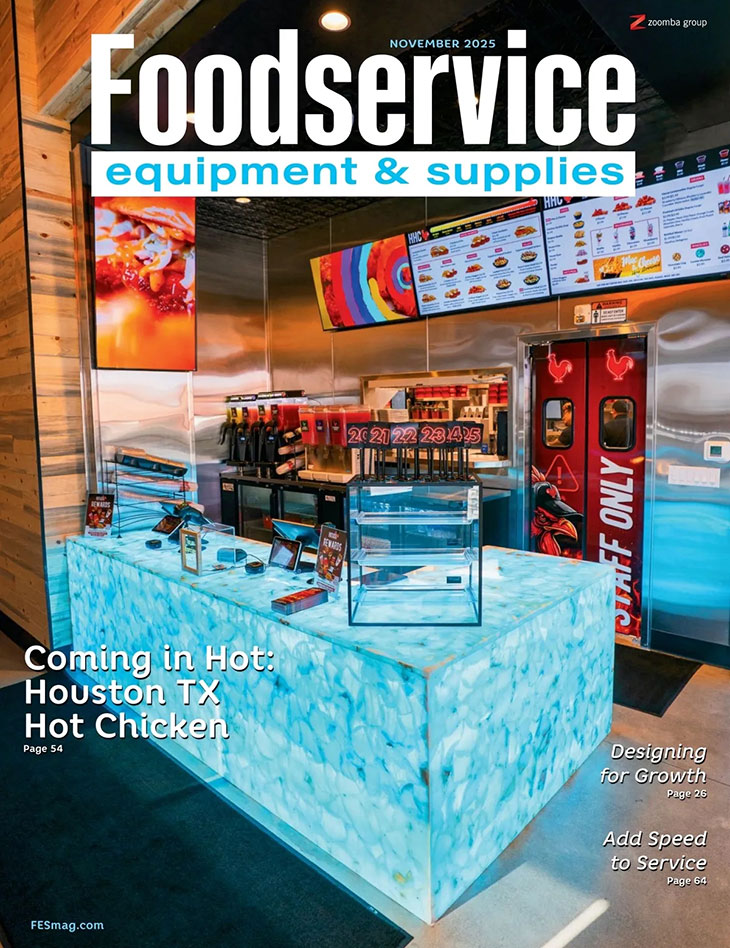Safety, quality and volume are key considerations with fry station design.
Although the makeup of fry stations may seem fairly basic, thoughtful design and consideration of all components ensures safe production for employees, helps speed of service, and yields quality product.
 Image courtesy of RealFood Hospitality, Strategy & Design.Fry stations typically consist of three main components: a freezer or refrigerator for storing items like fries, onion rings and chicken nuggets; fryers for cooking; and a dump station for draining and holding. Some operations may allocate space for breading, portioning and/or packaging. For these functions, the station may include a chef’s counter or another worktable.
Image courtesy of RealFood Hospitality, Strategy & Design.Fry stations typically consist of three main components: a freezer or refrigerator for storing items like fries, onion rings and chicken nuggets; fryers for cooking; and a dump station for draining and holding. Some operations may allocate space for breading, portioning and/or packaging. For these functions, the station may include a chef’s counter or another worktable.
Prior to designing a fry station, the designer and operator should seek to answer a handful of important questions. “The goal is to have hot and crispy food that is not soaked in grease,” says Alison O’Hearn, project manager, Cini-Little International.
“Elements to consider first include what type of food is being fried and whether it will be pulled straight from the freezer or freshly breaded and/or battered,” says O’Hearn.
Whether frozen or hand-breaded in-house, these food items rely on fast cooking and minimal holding times. “Fried food can get soggy quickly, says Jessica Gates, design project manager, foodservice, RealFood Hospitality, Strategy & Design.
The amount of fried food an operation anticipates making will dictate how many fryers it will require. “If an operation is only slinging fries, a 70-pound capacity fryer may be needed,” Gates says. “However, if there are a variety of products in smaller volumes, multiple fryers in smaller capacities may be warranted.”
Support equipment also varies, depending on the menu and volume. “Fry station holding units should retain food quality,” Gates says. “So rather than using just a heat lamp, this area may incorporate a drip station and holding station that includes a shallow bath with a heat lamp above and ventilation underneath. Seasoning can take place here as well.”
For example, frozen food will require a nearby freezer big enough to store a day’s worth of product; fried items prepared from scratch will need an adjacent breading station with room to store breadcrumbs, seasonings and batter. A dump station helps fried food retain proper temperatures while being held and may include a perforated pan to slough off excess oil.
“In addition to the menu and volume, the proper equipment lineup will depend on the necessary turnaround time,” explains Marcin Zmiejko, vice president, YoungCaruso. “If an operation only offers fries, it’s simple, but if there is more than one fried item on the menu, [the timeline] becomes more complicated.” For this reason, operations that prepare large volumes or varied offerings of fried food will have a battery of fryers and dedicated staff for the fry station. If an operation is heavy on catering or fried appetizers, additional cooking capacity may be necessary, too.
A menu of multiple fried items not only requires fryers, but the oil for each one needs to go through a separate filtration system. “If you have chicken fingers and fries, the design should account for the volume of both,” Zmiejko notes. “It may include three fryer bays with one filtration system for the fries and three more bays and a separate filtration system for chicken, for example.”
In some cases, kitchen designers may recommend centralized filtration systems. These systems generally run pipes from the fryers to a holding tank, typically by the back of the building, near the service entrance or by the loading dock. “This is more popular in larger operations with multiple frying locations, such as stadiums and hotels,” Zmiejko says. “Depending how far the fryer is from the point of exit, this setup can be pretty pricey.”
The station’s design also needs to consider the location and logistics of the refrigerator for fresh produce and the freezer for frozen pre-prepared food. “Whether incorporating an upright, reach-in or worktop freezer [or refrigerator] with breading station, this should be as close to the fry station as possible,” Gates recommends. “The fewer steps to retrieve product for frying, the better.”
Positioning of the exhaust hood is another important aspect. The fryer and other cooking equipment should sit completely beneath the hood. “If a ventilation hood is abutting the corner of a room, we’ll usually shift it over,” Gates explains. “And if the fryer is in the middle of the line, to maximize the exhaust potential, we will locate the [refrigerator and/or] freezer in an adjacent station away from the hood.”
Food allergies are another concern to weigh when designing a fry station. “Anything with an allergen that goes into a fryer will contaminate the equipment,” Gates says. “We can’t mix items that have gluten with food that is gluten-free.” If an operation offers gluten-free fried items on its menu, it should use separate and dedicated fryers.
O’Hearn adds that, for preprepared food from the freezer, a trash can will be needed nearby to dispose of packaging.
 Separation between the fryer and charbroiler is accomplished with a stainless divider to safely contain oil splatters.
Separation between the fryer and charbroiler is accomplished with a stainless divider to safely contain oil splatters.
Best-in-Class Layout
The proximity of equipment and flow of production are important considerations when looking at a fry station layout. The station is linear, with assembly generally moving left to right. “I work left to right, so I prefer to place the freezer first on the left side,” O’Hearn says. “If there’s a breading station, this goes next, and on top of refrigerated drawers is stored the egg wash and backup ingredients.” She suggests including five containers in the station design to hold breading ingredients.
O’Hearn typically recommends four separate vats for the fryer. “One is dedicated to gluten-free items, another for fish and the last two for everything else,” O’Hearn says. “Of course, this number is dependent on the menu.” She also includes at least three separate dump stations at the end of the line for different menu items.
“I like to keep fry stations close to dining rooms or at the end of the cookline and by the finishing station so fried items go out immediately,” O’Hearn explains. “I don’t want many steps between fryers and end customers since fried food shelf life is shorter.”
Due to high temperatures and grease splatters, fry stations are not the safest area in the kitchen. Keep this in mind with the design. “When frozen items are placed in hot oil, it sprays, so this station should not be too close to open flames from charbroilers or range tops,” Zmiejko says. “People have had design challenges due to this.”
Another critical safety component is the exhaust hood, which should have a fire suppression system that includes nozzles positioned above the fryers. “Fryer oil is very flammable, so when trying to be conservative with hood space, the proximity of equipment underneath it is critical to what the captured footprint will be,” Gates says. “The closer the equipment, the better, but a big splash guard is needed to separate fryers from ranges and charbroilers to contain oil splatters.”
Equipment Necessities
In addition to the fryers, freezers/refrigerators, and breading and dump stations, some accessories and equipment options can maximize fry station efficiency and productivity. “For example, fryers with hooks on the backsplash provide efficient draining,” Gates says. “Also, with drip units, baskets are hooked onto oil drip trays so fryer use isn’t hindered.”
Integrated or mobile filter drawers are another potential add-on. “There needs to be a place to park mobile filter drawers, but integrated drawers are built in and can be retrofitted in the field,” Gates notes. The drawers take the sediment out of fryer oil to maximize the oil life. Because oil is pricey and not easily disposed of, extending its usage helps offset the cost of the drawers.
With oil use a main consideration, operators have options to simplify maintenance requirements. “An integrated oil filter that continuously filters and tops off oil minimizes maintenance and labor and keeps oil cleaner, so it lasts longer,” O’Hearn says. “This not only saves money but also speeds up temperature recovery.”
Fryer technology has advanced and newer models continuously take oil temperature and automatically heating oil as necessary. Automatic basket lifts also are a labor-saving add-on.
Ventless fryers can be incorporated into kitchens with limited or no hood space. Though these units are pricier, there are savings as no ventilation hood is required. “Ventless fryers have been introduced to the market, and though these won’t replace all fryers, the units may be used in small retail foodservice operations since they require a smaller footprint than traditional fryers with ventilation systems yet still produce a quality product,” O’Hearn says.



